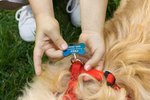Dog jumping harnesses fit over the dog's body and by restricting the movement of his rear legs, make it virtually impossible for the dog to jump up on people or counter tops. They are quite effective for most dogs, but should not be a solution for basic training, and have some safety considerations users should be aware of.
Features
Dog jumping harness work by restricting the dog's natural movement. When he tries to jump up, the harness tightens at the chest, pulling his rear legs beneath him so that he has insufficient balance for jumping. The harnesses are adjustable at several points for the dog's comfort and size. They are not available for very small dogs under 10 lbs., or dogs larger than 80 lbs. A dog wearing a jump harness can sit, lie down, walk and trot while wearing one, although they may be restricted from running at a full gallop. The owner can adjust the harness so the dog has a lot of freedom of movement.
Considerations
Jump harnesses may take a bit of practice to put on the dog, especially if the dog is unwilling (as most will be). They are not a substitute for basic training, but can be used as a tool to aid in training the dog. They are designed for short term use only and should not be left on a dog for long periods of time. Not only is it uncomfortable, it can easily rub the skin raw on the rear legs due to the frequent pressure and rubbing.
Benefits
It can be annoying and sometimes dangerous for larger dogs to jump up on guests, particularly children or elderly or frail people. While a jump harness prevents a dog from jumping, most dogs will still jump up when not wearing a harness--they are smart enough to realize the effect of the harness. The harness should be used as a tool, while still correcting the dog for jumping up, giving him an alternate behavior instead of jumping and rewarding him for keeping "four on the floor."
Prevention/Solution
Most dogs jump because it is a submissive greeting behavior. Consider the way puppies lick the muzzles of older dogs--this is just what most dogs are approximating when they jump on people. Even as small puppies, dogs should never be rewarded for jumping on people by picking them up, feeding them in response or simply accepting the behavior as cute or OK. Once a dog is allowed to get into the habit, it is only the owner to blame for letting it continue. Avoid greeting a dog until they have calmed down. If they try jumping up, turn away quickly and ignore them. If the problem you are trying to resolve is one of a dog "counter surfing" and taking things off kitchen counters, the easiest way to prevent this is simply to restrict the dog's access to the kitchen in your absence, or make sure there's nothing too yummy on the counters to attract him. Dogs are scavengers by nature and it can be very hard to break them of the habit. Sometimes management is the more intelligent solution.
Expert Insight
The fastest way to teach a dog not to jump up is by giving him an alternate greeting behavior. This can be anything from a sit and offer of a paw, to "sitting pretty" on the haunches, which is natural for toy dogs. If you teach any of these things when the dog is wearing a harness, make sure he has enough range of movement to perform comfortably.
Photo Credits
-
Doctors Foster and Smith catalog
Writer Bio
Stevie Donald has been an online writer since 2004, producing articles for numerous websites and magazines. Her writing chops include three books on dog care and training, one of which won a prestigious national award in 2003. Donald has also been a painting contractor since 1979, painting interiors and exteriors.



